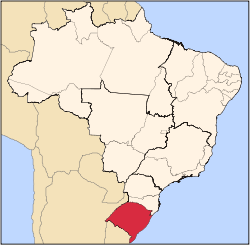Alto Feliz | |
|---|---|
 | |
| Coordinates: 29°23′S51°18′W / 29.383°S 51.300°W | |
| Country | Brazil |
| State | Rio Grande do Sul |
| Founded | March 20, 1992 |
| Government | |
| • Mayor | Paulo Mertins |
| Area | |
• Total | 79.204 km2 (30.581 sq mi) |
| Elevation | 285 m (935 ft) |
| Population (2020 [1] ) | |
• Total | 3,036 |
| • Density | 38/km2 (99/sq mi) |
Alto Feliz is a municipality within the state of Rio Grande do Sul, Brazil. It was raised to municipality status in 1992, the area being taken out of the municipality of Feliz. [2]



